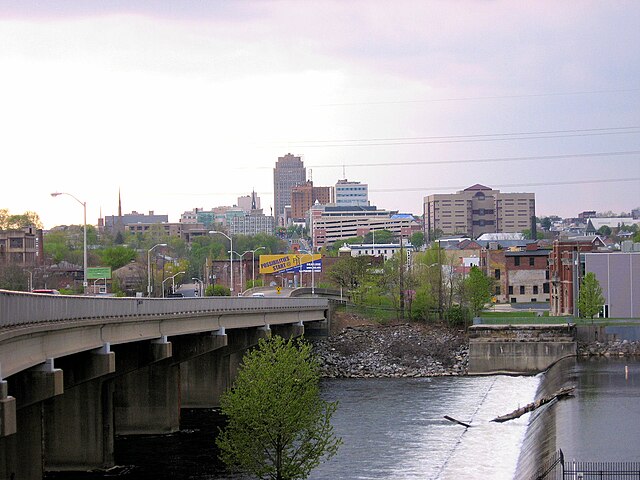Top Qs
Timeline
Chat
Perspective
Buildings and architecture of Allentown, Pennsylvania
From Wikipedia, the free encyclopedia
Remove ads
The buildings and architecture of Allentown, Pennsylvania reflect the city's history from its founding in 1762 through to the present.








Allentown is characterized by historic homes, churches, commercial structures, and century-old industrial buildings, some of which played a role in the American Revolution of the 18th century, or were centerpieces in the Industrial Revolution of the late 18th and early 19th centuries. Many of the city's homes and building structures rank among the oldest in the United States.
Remove ads
History
Summarize
Perspective
Allentown was founded in 1762. There are three historic districts in Allentown: Old Allentown, the Old Fairgrounds, and West Park neighborhoods. Old Allentown and Old Fairgrounds are Center City neighborhoods that hold a joint house tour organized by Old Allentown Preservation Association annually in September. West Park neighborhood also offers a tour of this district's larger Victorian and American Craftsman-style homes.[1]
The oldest standing structure in Allentown is Trout Hall, built in 1770 by James Hamilton, son-in-law of William Allen, the city's founder. Located at South 4th and Walnut streets, the home was later renamed several times. It was known as Livingston Mansion. In 1848, it became Allentown Seminary. In 1867, it housed the newly-established Muhlenberg College prior to the college's move to its present location off Cedar Crest Boulevard. In 1905, it was restored and is currently administered as Trout Hall by the Lehigh County Historical Society.
Miller Symphony Hall, at 23 North Sixth Street in Center City, was constructed in 1896.
Zion's Reformed United Church of Christ, founded in 1762, is located at 620 West Hamilton Street. The church's original structure was a log cabin Union Church it shared with the congregation of St. Paul's Lutheran. Zion's current building, a neo-gothic[2] structure built in the 1880s, hosts a sanctuary representing a high point in 19th-century church architecture, with stained glass art windows on all four walls interweaving biblical symbols with a floral motif, symbolizing the flowering of the new out of the old.[3]
Until 2023, Zion's Church also hosted the Liberty Bell Museum, due to the special role the church played in protecting the Liberty Bell from capture by British during the British occupation of Philadelphia in 1777. The Liberty Bell was hidden under the floor boards in the church's basement.
20th century
In the 20th century, rowhouses, many built in the Victorian or Federal style, became popular in Allentown. The West End neighborhood, which runs roughly from 15th Street to Cedar Crest Boulevard, is famous for both its brick twin styles closer to center city and large homes, including the Hess Mansion, which is located in the city's west-end.
The PPL Building, constructed between 1926 and 1928, is Allentown's tallest building at 322 feet (98 m). It is 23 stories high and is located at the northwest corner of 9th and Hamilton streets. A Lehigh Valley icon, the building's Art Deco tower is visible throughout the Lehigh Valley; in clear weather, the building's tower is visible as far north as Blue Mountain. The building was designed by architect and skyscraper pioneer Harvey Wiley Corbett, who later helped design Rockefeller Center in Manhattan and was supervised by his assistant, Wallace Harrison, who later designed Lincoln Center, LaGuardia Airport, and the U.N. Headquarters Building in New York City. The building exterior features bas reliefs by Alexander Archipenko.
In 1930, the PPL Building was named the "best example of a modern office building" by Encyclopædia Britannica and was featured as having the world's fastest elevator. Exterior shots of Allentown's PPL Building are featured in the 1954 movie Executive Suite.[4]
21st century
At the beginning of the 21st century, much of Allentown's office and retail space was vacant.
In December 2011, J.B. Reilly,[5] Alvin H. Butz[6] and other developers announced a series of new plans designed to bring service-based companies and white-collar workers back to the city while taking advantage of a special tax zone created for the construction of the new PPL Center at 7th and Hamilton streets.
In the early 21st century, some historic industrial buildings have been converted to loft-style rental apartments, including the Farr Lofts in Center City, the P&P Mill Building in the 1st Ward, and Auburn Station near the Good Shepherd Rehabilitation Center.
Remove ads
Tallest buildings in the Lehigh Valley
Summarize
Perspective
The tallest buildings and structures in the Lehigh Valley, (metropolitan Allentown) are:[7][8]
Remove ads
See also
References
External links
Wikiwand - on
Seamless Wikipedia browsing. On steroids.
Remove ads
